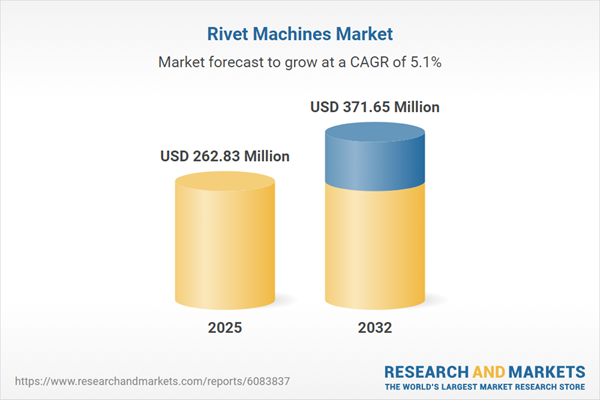Speak directly to the analyst to clarify any post sales queries you may have.
The rivet machines market is undergoing substantial transformation as manufacturers worldwide seek more precise and reliable joining solutions to enhance product performance and manufacturing efficiency. This report offers essential insights tailored for senior decision-makers evaluating technology investments, process optimization, and risk management in industrial operations.
Rivet Machines Market Snapshot
The global rivet machines market grew from USD 249.97 million in 2024 to USD 262.83 million in 2025, with projected expansion at a CAGR of 5.08%, reaching USD 371.65 million by 2032. Sustained demand is driven by the need for robust fastening in sectors like aerospace, automotive, construction, and electronics manufacturing. The market’s trajectory reflects a shift toward automation, performance-driven assembly, and supply chain adaptation in response to global pressures.
Comprehensive Scope & Segmentation Analysis
This analysis delivers a structured overview of both the application spectrum and regional reach of rivet machine technology. Strategic segmentation highlights current and emerging opportunities for stakeholders seeking operational excellence and competitive differentiation.
- Application Areas: Aerospace (commercial aircraft, defense aircraft), Automotive (car manufacturing, commercial vehicles, electric vehicles), Construction (commercial and residential projects), Consumer Electronics, and Industrial Electronics.
- Machine Types: Electric, Hydraulic, Manual, Pneumatic - each suited to distinct production scales and operational demands.
- Rivet Material Choices: Aluminum (lightweight assemblies), Stainless Steel (corrosion resistance), Steel (heavy-duty applications).
- End Use Industries: Aerospace, Automotive, Construction, Consumer Goods, Electronics.
- Distribution Channels: Offline (direct sales, distributors), Online (e-commerce, OEM portals), supporting both localized and decentralized purchasing strategies.
- Key Regions: Americas (North America—United States, Canada, Mexico; Latin America—Brazil, Argentina, Chile, Colombia, Peru), Europe, Middle East & Africa (Europe, Middle East, Africa), Asia-Pacific (China, India, Japan, Australia, South Korea, Indonesia, Thailand, Malaysia, Singapore, Taiwan).
- Major Companies: Stanley Black & Decker, Atlas Copco, Illinois Tool Works, Nordson Corporation, Ingersoll Rand, SPX Flow, Emerson Electric, Parker-Hannifin, Ametek, Arconic Corporation.
Key Takeaways for Senior Decision-Makers
- Precision and efficiency gains from automation are reshaping manufacturing operations, with rivet machines integral to quality assurance and streamlined workflows.
- Technological advancements, such as smart controls and digital interfaces, are enabling predictive maintenance and reducing unplanned equipment downtime.
- Ongoing investment in sustainable equipment design addresses regulatory and market expectations for reduced energy use, lower noise emissions, and recyclable components.
- Diverse material compatibility and modular architectures equip manufacturers for increasingly complex, mixed-material assemblies and frequent product transitions.
- Human-machine collaboration features reduce training times and operational risk, fostering higher workforce productivity across varied skill levels.
- Strategic supplier networks, local sourcing, and digital sales channels have become vital for mitigating disruptions and maintaining operational agility.
Tariff Impact on Supply Chains and Costs
Recent tariff enforcement in regions such as the United States has prompted manufacturers to review procurement strategies, emphasizing local partnerships and alternative sourcing. The ripple effects include updates to logistics planning, smarter inventory management, and intensified negotiations throughout the value chain. These shifts are especially significant in cost-sensitive downstream sectors like automotive and aerospace.
Methodology & Data Sources
This report integrates primary interviews with machinery manufacturers, suppliers, and end users, alongside secondary research from published technical articles and regulatory documents. All segment analysis is supported by peer-reviewed validation, and trade association data underpins scenario modeling aimed at providing actionable, transparent recommendations.
Why This Report Matters
- Enables informed capital allocation and technology roadmap decisions by synthesizing actionable market intelligence.
- Guides procurement and risk management strategies in response to regulatory change, market dynamism, and regional divergences.
- Equips leadership with a holistic view of evolving technologies, supply chains, and end-use applications relevant to their growth objectives.
Conclusion
Rivet machine technology is central to advancing manufacturing productivity, quality, and sustainability. Informed decisions based on this comprehensive analysis will empower senior leaders to adapt confidently and capture value in a rapidly evolving global market landscape.
Table of Contents
3. Executive Summary
4. Market Overview
7. Cumulative Impact of Artificial Intelligence 2025
Companies Mentioned
The companies profiled in this Rivet Machines market report include:- Stanley Black & Decker, Inc.
- Atlas Copco AB
- Illinois Tool Works Inc.
- Nordson Corporation
- Ingersoll Rand Inc.
- SPX Flow, Inc.
- Emerson Electric Co.
- Parker-Hannifin Corporation
- Ametek, Inc.
- Arconic Corporation
Table Information
| Report Attribute | Details |
|---|---|
| No. of Pages | 185 |
| Published | October 2025 |
| Forecast Period | 2025 - 2032 |
| Estimated Market Value ( USD | $ 262.83 Million |
| Forecasted Market Value ( USD | $ 371.65 Million |
| Compound Annual Growth Rate | 5.0% |
| Regions Covered | Global |
| No. of Companies Mentioned | 11 |









